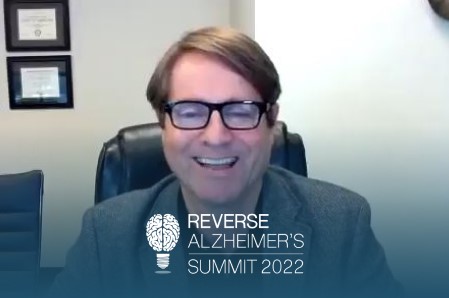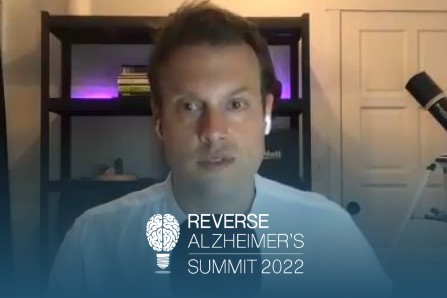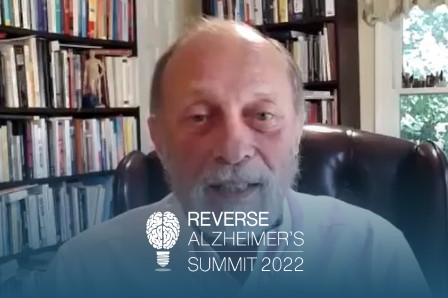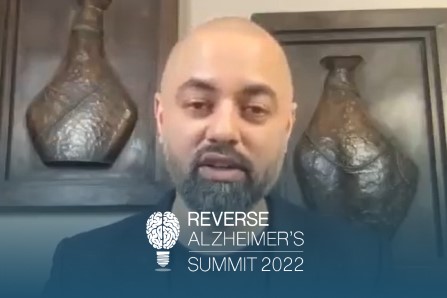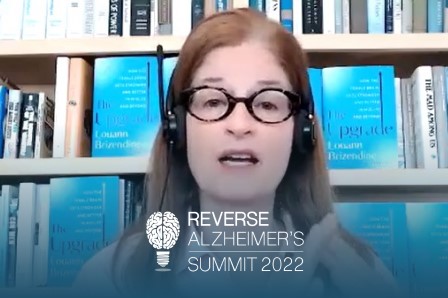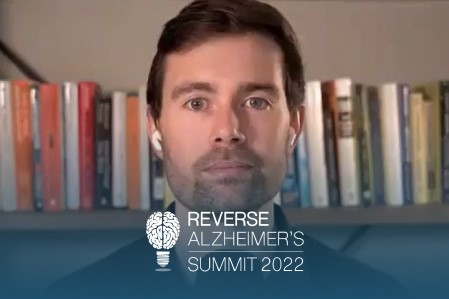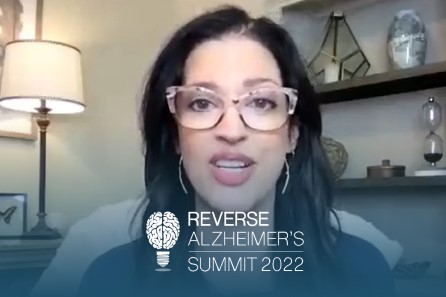Join the discussion below

Dr. Bredesen earned his MD from Duke University Medical Center and served as Chief Resident in Neurology at the University of California, San Francisco (UCSF) before joining Nobel laureate Stanley Prusiner’s laboratory at UCSF as an NIH Postdoctoral Fellow. He held faculty positions at UCSF, UCLA and the University of... Read More

Dr. Wes Youngberg is a practicing lifestyle medicine specialist and clinical nutritionist in Southern California. He was trained at Loma Linda University where he received a Master’s in Nutrition and a Doctorate of Public Health with expertise in Preventive Care. He has authored multiple books on Preventing and reversing diabetes;... Read More
- Discussion as to the factors most commonly responsible for a patient’s cognitive improvement.
- Insulin resistance is the most common and often the primary underlying trigger of dementia.
- The most sensitive and effective way to measure insulin resistance in patients is with a Glucose Tolerance Test that includes
- Insulin measures at fasting, 1-hour and 2-hours at the same times as the glucose measurements.
- Extending the Glucose Tolerance Test with a 3-hour and 4-hour Glucose helps establish if the patient has reactive hypoglycemia
- Which is a major risk factor for hypocampal neuron death and progression of dementia.
- A more comprehensive and inexpensive assessment of a patients genetic mutations is possible using the “raw data file” from a
- 23andme.com saliva test and the MTHFRsupport.com report. This goes way beyond EPOe4 and MTHFR mutations.
- Understanding where the genetic mutations are gives us specific understanding on how to improve the downstream biochemical impairments related to each mutation.
- It’s important to understand that sensitivity to various toxins and exposure to chronic low grade infections lead to chronic inflammation and therefore greater insulin resistance.
- Testing for mycotoxins, glyphosate, industrial toxin load and heavy metals is a critical step in helping patients restore cognitive function.
- Please provide 5 interview guide questions. Please be advised that these questions may or may not be used
Dale Bredesen, M.D.
Welcome everyone once again to the Reverse Alzheimer’s Summit. It’s a great pleasure and honor today to welcome Dr. Dr. Wes Youngberg . Wes, congratulations on the fantastic work you’re doing and all the wonderful success you’ve had. And thanks for joining us today.
Dr. Wes Youngberg
Well, I had a great teacher, so I’m glad to be here.
Dale Bredesen, M.D.
Good to hear that. And everybody comes from a different background. The one of the things that’s been exciting to me about dealing with patients with cognitive decline is that each practitioner brings something different. There are scientists, there are neuro-psychologists, there are neurologists, there are internists, there are family practitioners, on and on, integrated physicians. And you bring a background of really of diabetes work, work with metabolism, work with nutrition in your doctorate. So tell us a little bit about how you got to the field of cognitive decline.
Dr. Wes Youngberg
What’s interesting, I began my passion, my interest for lifestyle nutritional medicine, when I was a child, I found out my mother was dying of brain cancer. At the age of nine, I learned this and it changed my life. It made me become very, very interested in health and medicine, but preventive strategies. I remember as a teenager, I said to my dad, I says, “What can I do now so I can prevent what happened to mom in my life?” And without realizing that that was the watershed moment that led me into just reading everything I could find about health, and later I ended up at Loma Linda University and studied, did a doctorate of public health in clinical preventive medicine and basically, lifestyle medicine. And along the way, I did a Master’s in clinical nutrition, and that’s what got me into all these areas. And of course, I first started tackling the question of diabetes, when Dr. James Anderson from the University of Kentucky, Lexington, came to Loma Linda University, and he was talking about how you could reverse diabetes. And I go, like, “Why isn’t more people excited about this?” This was back in the early eighties and he’d been doing it since the early seventies. And so, that’s when I learned about insulin resistance and all the underlying triggers that led to the diabetes in the first place. And so, it was when I read your 2014, I believe, study on the novel approach to reverse cognitive decline that hooked me. And that’s what got me into your training program, because in reading your report on those 10 individuals that had able to reverse cognitive decline, it became very clear to me that insulin resistance was a key driver of cognitive decline. And that’s when I realized that I was gonna become a subspecialist in reversing cognitive decline, because I already had the most common driver of cognitive decline as a subspecialty in my clinical work.
Dale Bredesen, M.D.
Absolutely. And what percentage of your clinical practice is now devoted to cognition?
Dr. Wes Youngberg
I take all-comers, right? So I’ve always been that way, but the reality is I just saw three new patients today that were interested in the Bredesen protocol. And so, I have patients that are coming in at all levels of cognitive decline. Some of them are really wise, they’re recognizing that they have risk, we all have risk.
Dale Bredesen, M.D.
Absolutely.
Dr. Wes Youngberg
And they’re recognizing at an early age that this is the time to tackle that risk and to develop a truly preventive protocol that protects them against cognitive decline. And then other, we had a patient today, who she realized after reading your book and then reading my book that this word fishing, what’s that word again? Is not just normal aging. I mean, it might be average aging, but it’s not the way it’s supposed to be. And so, she decided to take a preemptive approach and address it now where it’s in an area of subjective cognitive impairment, moving into mild cognitive impairment. And we’re getting her all set up to address this and doing all the labs. And I tell them the more underlying risk factors that we discover from the recode approach here, where we are looking at as many risk factors as we can find. I tell them, “The more we find, the better chances we’re gonna have of helping you, not only prevent cognitive decline, but begin to reverse the aspects that have been troubling you today.”
Dale Bredesen, M.D.
Absolutely, I think that’s a really good point. And I think the whole term of mild cognitive impairment really concerns me, because it is like saying to someone, “Don’t worry, you only have mildly metastatic cancer.” It is a relatively late stage, it’s the third of four phases as you get it, it’s after SCI it’s after your presymptomatic phase. So I’m hoping that everybody will come in ultimately, either for prevention or for during SCI, which lasts on average, about 10 years. I still remember this is about 1996 or so, when the late Professor Leon Thal, who was at UC San Diego, told me about this thing that he called mild cognitive impairment, which as he pointed out about 5-10% of these patients would convert each year to full-on dementia. And of course, now we know we can see things, you’ll see this coming much, much longer ahead than that. So I think it really offers us unparalleled opportunities to make Alzheimer’s a rare disease, which is just what it should be.
So if you could talk a little bit about your program. I just got back from couple of talks in Miami and in Tennessee, and one of the common issues that came up was well, okay, we see what you’re talking about, but it’s too many different things, how are we gonna get these going? So in your practice, you’re dealing with, as you said, you’ve gotta look for all the different things. We know now that this is more of a coordinated system of neuroplasticity. There are synaptoblastic and synaptoplastic effects. You’re looking for various toxins, you’re looking for energetic failure, you’re looking for insulin resistance, you’re looking for oxygen de-saturation and things like that. How do you address this in a very practical way with your patients?
Dr. Wes Youngberg
Yeah, I actually have now a blurb on the documents that I email back to patients after each visit that I have with them. I made a conscious decision early on in my practice that I would commit an entire hour for every consultation I do. And I know not everybody can do that, but because I’m really sub-specializing in this, I only take six patients a day, and I spend a whole hour or more with each patient at every phase of the protocol that I’m developing with them, because I need to really listen to them. Yeah, we’ve heard that the phrase, if we listened long enough to our patients, they’ll tell us exactly what we need to do for them. And sometimes I’m not actually figuring out what the real issues are until the second or third visit that I’m really talking to them, and they’ll say something, just in passing, or go like, “Wait a minute, you didn’t tell me that before. And so, the more we interact with our patients and let them talk, let them express themselves and share their concerns, the more likely we are to pick up one additional risk factor, that might be that risk factor that brings us to that tipping point that will lead to more significant improvements or a decrease in the progression of that level of cognitive decline. So I always tell patients during the first visit, I say, “First of all, you can fire me at any phase of this program.” I said, “I’m here for you.
If this isn’t working for you, then maybe you need to find somebody else.” But I always tell them, “So I’m gonna do everything possible to leave no stone unturned,” to figure out what it is, what the multiple factors are that are contributing to their cognitive decline or their cognitive decline risk. And so, I say, there’s actually three goals. And of course, the third goal is that reversal of cognitive decline. I said, that’s obviously, we all have that goal, but let me suggest that two other goals are even more important at the beginning phases of what we’re doing. The first of the third goals is to make sure that we’re doing enough to slow down cognitive decline. And I suggest to them that I believe based on my experience and my reading in the field, that we can do that 100% of the time, we can slow it down at some level. And one example of this, is some patients, especially family members that might be caretakers or what I call health partners of that individual who has the concern, might be thinking, “Wow, it’s just a little bit of memory issues. It’s not a big deal.” I don’t know if doing a comprehensive protocol and doing all these labs and changing our diet, changing our lifestyle and taking these supplements, et cetera.
I’m not sure it’s worth the energy and time and effort to put into this. And so, I actually tell ’em a couple case studies that I’ve had recently, ’cause I get patients at all stages of cognitive decline, from just I just wanna prevent it from happening, don’t even have a family history, I just wanna be on top of it, all the way to there’s advanced Alzheimer’s for already five years in my book. I had the case study of a patient who’d already had advanced Alzheimer’s for five years where a neurologist was saying, “Hey, I know Wes, went to school with him, I’ve heard him lecture at a conference and man, I’ve never seen this happen, but hey, I don’t know what else to tell you, give Dr. Youngberg a call.” And so, I deal with patients at all stages of cognitive decline. And so, the key here is that is that there’s three goals. Number 1, slow it down. Number 2, let’s try to stop it. And I believe that in many patients, about 90% of the time, we can actually stop it, we can stop it. And the crude example that I use for these patients that think it’s not a big deal, potentially, I said, I had a patient recently that she went into the restroom in her home, the bathroom, and literally had forgotten how to have a bowel movement. See that’s a memory issue as well, obviously, a cognitive issue.
And so, she’s confused, she’s in the restroom, she has the need to have a bowel movement. So she has a bowel movement in her clothes. She then reaches back and grabs feces and wipes it on the seat. And just doesn’t know, she has forgotten how to have a bowel movement. And after two months of working her husband, just doing everything possible, encourage her to get all these foundational strategies, to sleep, to exercise, the diet, making sure, ’cause somebody at that level, they have no control, they’re not gonna change. They’re gonna do all the wrong things if allowed to make all the choices. And so, the caregiver or the husband in this case was the key change agent for his wife. And within two months, she’s now able to go into the bathroom and have a normal bowel movement and knows what to do. Now that’s an example of reversal. That’s more critical in my mind, reversing a short-term memory problem that somebody maybe forgot something that happened yesterday, depending how important that information was. And so, individuals who have seen a family member go through this already have a much better understanding of why it’s worth every ounce of effort to put into it now to number 1, slow down that decline, and if you slow it down enough, it’s like prostate cancer, the average prostate cancer in men. If you slow that down enough, it’s never gonna be a problem. And then number 2, stop it, number 3, begin to reverse that process.
So I always explain it that way to my patients so that they know what to expect and that even if they’re not noticing any improvements in the first couple of months, I always explained to them, I says, “Listen, you have to compare this to what otherwise would’ve been.” Of course, we’re dealing with a study of one at this point, but we’re recognizing and helping them recognize that we’re slowing down or potentially stopping progression. So that’s why I have them on a weekly basis, keep a journal of cognitive changes, good or bad. Okay, if there’s one thing that would properly describe cognitive decline or cognition over time, is this undulations. Even while somebody’s on this amazing medicine protocol, there’s gonna be ups and downs, life happens. But they can learn from those up and downs. And we see the trend analysis where now we’re improving over time, even though the ups and downs still occur at times, we’re seeing an overall trend for improvement and that excites patients when that happens.
Dale Bredesen, M.D.
Yeah, it’s a great point. Now, as we talked about, you are an expert in metabolism, but as you got going on this, you I know, became an expert also in dealing with bio-toxicity, in part, because that’s such a common problem. We have many people who are practicing, but they just avoid that part of it. You saw obviously, that a lot of people have this. What percentage ballpark of the people who come to you have some degree of bio-toxicity?
Dr. Wes Youngberg
Well, my experience is most, and the reason I say that, I’m not saying it’s necessarily the most important or critical part of their risk factor profile, but that’s the whole point of this protocol that you’ve developed is figuring out, is making sure we’re doing enough of it to get to that tipping point where the body’s able to heal as opposed to gradually breaking down. And so, I do toxicity analysis as a second, sometimes third tier, ’cause there’s so much to do, with the metabolic analysis. I began not only looking at the hemoglobin A1C and the fasting glucose, but I actually do a four-hour glucose tolerance test with insulin and cortisol through those four hours on every patient. If this isn’t just my cognitive patient, I’ve been doing this for 30 years with all my patients, because I find what I call this perfect storm or what happens is that you may have a perfect metabolic fasting glucose of let’s say 70 to 85. It’s the optimal range. Optimal range is much lower than the beginning of prediabetes. In fact, in my mind, prediabetes is actually stage 3 hyperglycemia. So there’s two stages of high blood sugars to come even before prediabetes. And the most sensitive way to establish that this is a concern is by doing a glucose tolerance test, that includes one hour, a two-hour blood sugar to see how high the blood sugars go.
Yeah, and that can even get you into the pre-diabetic, diabetic scenario, ’cause there’s a lot of diabetics that, well, let’s put it this way, if we just use an A1C to diagnose diabetes, we’re missing 73% of individuals that are diabetic, based on the glucose tolerance test. And so, the glucose tolerance test gives us, but this was a study done at the City of Hope. They have a whole endocrine section, because of the relationship between insulin resistance, diabetes and cancer. And so, doing a thorough evaluation of a glucose tolerance test, picks up all kinds of hyperglycemia and hyperinsulinemia, especially not only a fasting insulin, but a one hour insulin along with the one hour glucose after a 75-gram glucose load, or 300 calories of your favorite sweets or carbohydrates, if you prefer. And then, the second hour, which of course is officially diagnostic for either prediabetes or diabetes. Prediabetes 140 plus, diabetes 200 plus. So, but the insulin levels at 1 and 2 hours are the most sensitive indicator. I have patients have perfect blood sugars, a perfect little curve of blood sugars, no elevation whatsoever, not even into the first or second phase of high blood sugar, and yet their insulin levels are sky high. In other words, they have insulin resistance, but their pancreas is hardy enough to produce enough insulin to compensate.
Dale Bredesen, M.D.
Where do you wanna see the insulin at that time?
Dr. Wes Youngberg
So, well, I say that ideal insulin is under five. I want it at least under 10 fasting. And then, and between, the goal is under seven, but ideally under five. So that’s for fasting. Of course, when you look at insulin levels, you have to consider what the blood sugar was at the same time.
Dale Bredesen, M.D.
Exactly.
Dr. Wes Youngberg
If you have an insulin of four, which normally we say, that’s great, but the fasting blood sugar is 100, which is the beginning of prediabetes, there’s a disconnect between the pancreatic output, the beta cell output and the blood sugars. And so, so clearly there is now apparently at least, there is a beta cell defect which could be due to low-grade infections, could be due to toxins, insulin resistance has more to do with toxicity than it does with excess weight. A lot of us kind of documented that. So, and then I look at the third and the fourth hour, glucose and cortisol at those hours as well, to see if that person has a drop off or what we call a reactive hypoglycemic crash. So from a neurologic standpoint, or from a hippocampal stress standpoint, we know that hyperglycemia is bad for the hippocampus, hyper-insulin anemia will impair beta amyloid scrubbing or detoxification, because the insulin-degrading enzyme, its main job is actually getting rid of oxidized beta amyloid. So too much insulin is really bad for the brain, because that limits the amount of detoxification going on in the brain at any given day. And then, the hypoglycemic reaction is potentially even the worst of the three, but it’s related to the three, because if the blood sugar goes up, the insulin goes up typically, and then there’s a reactive drop in blood sugars, because of the excess insulin as it’s coming down.
And so, that low blood sugar we know basically, blows up hippocampal memory cells. And so, you can lose hippocampal mass or volume with any one of those three. And especially, if all three are present. And I find a significant number of my patients have both initial hyperglycemia, initial hyperinsulinemia, and then hypoglycemia an hour or two later, followed by a rollercoaster of cortisol. And that’s equally bad for the brain as well. So, the metabolic side actually then ties in to the evaluation of toxins, because I have quite a few patients that don’t have the traditional insulin-resistant or metabolic syndrome. They don’t have, they’re not significantly overweight, they may exercise on a regular basis, but when I do a glucose tolerance test, their insulin levels are through the roof. And it’s going all over the place. And so, I suspect in those cases that there’s either some type of low-grade infection, that’s persistent, that’s driving inflammation and insulin resistance, or there is a toxicity issue, which of course is always the problem with infections. It creates toxicity issue. It could be mold or micro-toxins, it could be heavy metals, it could be industrial toxins, glyphosate. And so, at some phase and once we get through the initial set of the recode labs, then I will add in evaluation for the HLA-DQ for mold or biotoxin susceptibility.
I will add in a micro-metrics test for mold in the home or the business. I will add in, I use the Great Plains laboratory to measure micro-toxins, in the urine, glyphosate, industrial toxins, et cetera. And I find some level of toxins in everybody when I do all three of those toxin tests. And I just consider it as one thing that if we’re dealing with cognitive decline or cardiovascular disease or some other type of immune issue it’s just reasonable to include a thorough evaluation of toxins. And then I appreciate your work with Dr. Neil Nathan, who has really made this clinically more reliable and clinically more obtainable, and doable for the average patient, so that we don’t have to have a detox protocol that overwhelms the patient where they’re having to do something 4 or 5 times a day. they can do it more, all at the same time, away from other supplements, medicines or food, and begin a gradual, but effective detox program.
Dale Bredesen, M.D.
Yeah, great point. Now what happens when you see the people who simply cannot make the insulin? So, instead of having high insulins, these are people that come in with a fasting glucose of 105, for example, and have a fasting insulin of 1.2, that sort of thing. What do you do with those people?
Dr. Wes Youngberg
Yeah, yeah. So the first thing I do is I’ll do that four-hour glucose tolerance test to see if that disconnect that differential between insulin and glucose persist at 1, 2 hours and so forth. Sometimes I’ll check insulin at 3 and 4 hours as well, depending on the situation, then we’ll look at the C peptides sometimes. That’s not as important unless somebody’s on insulin. But it’s just another way to evaluate the body’s production of insulin under different stress scenarios. The key here as I oftentimes will, in those cases, if I confirm that the insulin response to glucose is way substandard at 1 and 2 hours, then clearly there’s a beta cell defect there. And I will look for, is there an autoimmune issue? Like the GAD65 antibody or the insulin auto-antibody. There’s three different antibody tests that we can measure to pick up, to see if there’s any autoimmune driver of the beta cell dysfunction. And if so, then of course, that auto-immunity in my mind, as I’ve researched auto-immunity, essentially strongly suggest that we need to evaluate for low-grade infections and toxins. It’s usually one of those two that is literally leading to that autoimmune exacerbation. And, it all ties together. You really have to do the full protocol or the full assessment of the protocol, before you fully understand any piece of it.
Dale Bredesen, M.D.
Absolutely, and I know you’ve had some excellent results. Tell us a little bit, for example about, a patient who’s done well and the sorts of things that you addressed for that patient, if you would?
Dr. Wes Youngberg
Well, one example is the main case study that I put together in my book, “Memory Makeover: How to Prevent Alzheimer’s and Reverse Cognitive Decline”. In that book, I basically tracked a couple that was referred to me by a neurologist who just didn’t have anything else that he could do. He’d done the hippocampal volumetrics, and it was essentially less than first percentile. This is the patient of his, that he’d diagnosed with advanced Alzheimer’s over five years before. And he was basically telling her husband that he was dealing with, he says, “You gotta put her in a care home. You’re gonna burn yourself out, there’s nothing you can do.” And he was just begging him, “There’s gotta be something we can do.” And the difference in these more advanced cases, where people would have in of themselves an inability to really understand how to do the protocol, if this is a spouse or a family member, or an adult child really takes on this project and make sure that the protocol’s being followed, that the fundamentals are there, that the diet is a deal-breaker. If you don’t follow in the diet, you’re very unlikely to show success. If a family member’s bringing lemon cake twice a week, or whatever, I love lemon cake, but I know that if somebody has problems with cognitive decline or they already have a hippocampal volume that’s under 15 percentile, they know they don’t have a lot of reserve to work with.
And we have to guard that as much as possible. And the good news is that while it’s true, that many of these patients are losing over 1,000 hippocampal cells a day, the research shows that you can actually gain seven, 800 or more new hippocampal cells a day, if you remove the things that are holding it back. And that’s the toxins, that’s the high blood sugars, or the low blood sugars, or the lack of optimal sleep. And all the things that you have so effectively outlined in the recode protocol, we need to take advantage of those, but by doing so, we can regain hippocampal volume, meaning we’re gaining 1,000 or so new hippocampal cells every day. And so, this one case study, I actually conferred with you several times about this case study, because I didn’t even know if I wanted to take it. I was like, “Wait a minute, this is advanced Alzheimer’s for five years,” I didn’t wanna give her husband, I didn’t wanna give him false hope, but I also pointed out to myself that everybody deserves to be given some hope. Yeah, because there’s so much that we can do, there’s so much available to us in this protocol that we can begin working on. And so, making a long story short, I actually spent, I spent an hour with them every month for 18 months.
Now, I don’t usually do that. I usually say that most of my patients, I tell ’em, “I wanna spend as few sessions with you as I can, to get you up to a maintenance protocol.” And we can follow up maybe once or twice a year, depending on what the risk factors are, making sure that we’re making adjustments in your overall plan, but most people are gonna take about 5 or 6, one hour consults to get them to that point. Some people take a lot more like this advanced case. Now I’m only seeing them once a year now. So this is a patient had advance Alzheimer’s for five years. After four months, the sundowning syndrome completely gone. I mean, this lady was packing her bags and wanting to be with her mother, who’d been dead for 30 years and walking out of the house for 3 to 4 hours every evening. And this had been going on for years, three years. Can you imagine the disruption in your life, if you’re spending four hours every evening. She’s trying to keep your wife from going outside and getting lost with her suitcase. Well, within about three months of following the protocol, which to his credit, he figured out a way to get her to exercise. So people say, “Oh, my spouse would never exercise.” They’re not gonna exercise well, hey, be creative. Find a way to make it work. And he basically discovered that she loved to go on little drives. So he’d take her a little drive to the mall, they’d go walk around the mall or walk inside the mall.
So he took the time to figure out what it was gonna take to get her to exercise every day, ’cause without that, it probably wouldn’t have worked very well. So a lot of these strategies are deal-breakers if they’re not followed. You need to follow multiple strategies at once before you’re gonna get the results. So that’s why I think some people don’t get results, because they’re too uni-dimensional. They’re saying, “Oh, I’m really good at dealing with this, so I’m gonna focus on this part,” but they forget the other aspects of the recode assessment, which are maybe equally or even more important than the one that we might be really good at. So, well, we have to be willing to expand our horizons clinically, especially in this area of cognitive decline. So, the sundowning syndrome went away within three months, never came back, never came back. It did come back one time when she accidentally fell off the bed, broke a hip, had to go in for rehab, and during the rehab was a nightmare, because of course, they wanna feed her the regular rehab food, and so forth. And so, again, my friend, her husband, he figured out a way to sneak in the smoothies with all the supplements in it. And he learned, you don’t ask permission to do that, because then that sets you up for medical legal issues. And so, that he figured it all out and he did it and it worked, and that would reverse again. So, the good news was that after a year and a half of doing the protocol, she had totally forgotten all family members, not recognized anybody for years, drove four hours to visit her sister, he drove her, and she now was aware of where she was, she was spatially-oriented.
She said, “Hey, you’re supposed to turn back there.” She actually started understanding, what was in place in time, where she had no understanding of time or place prior for at least three years prior to doing this protocol. And then when she got out of the car at her sister’s place in another city, she saw her sister and she ran to her sister and hugged her, called her by name. And with her and had a wonderful discussion of them growing up together and so forth. None of that had happened for three years. So, that was so rewarding to me, of course, to him and to her and her sister. And now, I said to him, because there’s so many, you’ve heard many times say, “Well, there’s just too many supplements to take, this is just too much work. Let me know when it’s only three things that I need to do, and then I’ll do it kind of thing.” So I said to him, after all this had improved, I said, “Hey, John,” not his real name, but I said, “Hey, John,” that’s in his book “Pseudonym”, I said, “Hey, you’re actually, spending a lot of money on the supplements for this protocol. Do you want me to help you kind of tone that down, significantly save money?” “Not on your life,” he said. I go, “Really?” He said, “I did the math on what it would cost to have my wife in a memory care center.” And what I’m spending on supplements is not even a fraction of what I would have to spend. I would have to mortgage my house, I would’ve lost my house, and they wouldn’t have even anything to really benefit her other than just take care of her.
Dale Bredesen, M.D.
Yeah, it’s a really good point.
Dr. Wes Youngberg
And so, I always remember that, because as sometimes we get concerned about what the effort and the money we’re spending on the actual program, that’s nothing compared to the cost, if cognitive decline progresses, nothing.
Dale Bredesen, M.D.
Exactly, yeah.
Dr. Wes Youngberg
It’s the best deal ever. So, now three years after the beginning of them starting the Bredesen protocol, which was managed by the husband that his wife would’ve never been able to do this on her own. He says, to me, says, “Doc, I have my wife back. I’ve had my wife back for three years now. For the five years prior to that, I did have my wife. She was in the house, but she was not present. Now she’s present.” She’ll come into the room and stick her tongue out at me and laugh like we did when we were young. And I just feel so good to have her around. She still technically has Alzheimer’s. But that doesn’t matter, because he has his wife back. And she is now functional, she’s able to do things that she hadn’t been able to, many things, that she hadn’t been able to do for five years prior. So that to me is a great example of somebody being at the end, and they actually came back enough, even though there’s still an Alzheimer’s, just no longer that advanced form of just being an invalid, not being able to do, more of a vegetative state.
Dale Bredesen, M.D.
Yeah, exactly.
Dr. Wes Youngberg
And now they have that connection together again.
Dale Bredesen, M.D.
Yeah, it’s a great point. So you brought up an important point, which is the cost. And people ask about this all the time. The average cost for a person in the United States who goes through Alzheimer’s disease is $350,000 spent, of course, a lot of that in nursing homes. And so, I usually tell people, “Look, take one 10th of that, it’ll probably last you for the rest of your life, if you do the right things, you stay out of the nursing home. What would be your ballpark estimate if you’re going to the doctor, if you’re taking appropriate supplements, you’re doing even health coaching, what would be your ballpark for what do you think someone would spend in a year?” Again, if you go into a nursing home, it’s gonna be something like 90, 100, $110,000 per year, what would be your ballpark for what it would take to do the approach, the protocol personalized for you?
Dr. Wes Youngberg
Yeah, my experience is that it’s roughly 10 to 15% of that cost. I think, it’s reasonable to expect that they would spend maybe up to $15,000 a year. Now that’s if they’re doing a lot of stuff. And I feel bad when patients are being asked to pay out a lot of money up front for big programs. I think the recode program is the best deal ever, because, for just around $1,000 or less, they have access to so much information, the best health risk appraisal I’ve ever seen. And I used to be the director of corporate wellness for Loma Linda University. I mean, a wonderful health risk appraisal, and it’s detailed, it just gives you so much information. And then if you have access to a health coaching and to a Bredesen provider that understands how to apply the program overall, in my experience, it’s gonna take a monthly visit for a period of 6-8 months, to go through the toxicity. I spend about two full sessions on genomic analysis alone, which I know a lot of doctors don’t do, but I did a thorough review of 23andMe, not using their interpretation, but using their raw data. And using other apps like MTHFR Support. a 50-page document.
And then of course, I spent thousands of hours studying genomics to figure out what to do. And so, I have a 24-page narrative document, I put together that I look at, about the top 150 genes and their mutation snips that give us clues of what to do. And here’s what I say about genetics. See, we were all trained that genetics is a non-modifiable risk factor. That’s really misleading, because while we can’t change the gene itself, we absolutely can change the expression of the gene. And we absolutely can change the downstream biochemical effect of that gene, knowing where the mutation is. So if it’s a MTHFR 677 mutation, for instance, we know precisely the biochemistry of that gene defect, that leads to an enzymatic defect, that leads to a biochemical defect downstream. And so, we know that if we just appropriately supply the methylated folate and the methyl B12, et cetera, that by checking homocystine and other related snips as well, we can figure out to how to undo or neutralize the negative downstream impact of that genetic mutation. And so, I find that it’s extremely helpful to spend at least one full session, preferably two full sessions, because we get into clotting factors. Dr. Bredesen, I found out 10 years ago when I did that for myself, that I was factor 5 Leiden mutant.
Dale Bredesen, M.D.
Oh.
Dr. Wes Youngberg
So, and then I helped my family figure this out. I probably have 15 extended family members that are factor five mutant. And which means that even with the heterozygous single copy mutation of factor 5, that’s about an 800% greater risk of having a blood clot. That’s really important to know.
Dale Bredesen, M.D.
So do you take-
Dr. Wes Youngberg
Supposed to be in the age of COVID, right? So yeah, the genetics is a wonderful way to help us understand what else we can do. It is not, and even the APOE4 mutation, it’s not fully penetrant. It’s not fully deterministic. It gives us an understanding of what else we need to emphasize, to do better and reach our goals.
Dale Bredesen, M.D.
So talk a little bit about your immersion program. I know you’ve had immersion programs with your patients and I realize with COVID things change, but certainly even pre-COVID, you were doing immersion programs. And what’s your takeaway on these? Has there been success, do you find it’s helpful? Do people share information? Does this help with best outcomes?
Dr. Wes Youngberg
Yeah, so the immersion program I did was basically, a 15-hour program where we literally, I did presentations for an average of five hours a day. So it was actually over a four-day week where patients and their family would fly into to San Diego, and we had this set a resort at Coronado Island, the Marriott. So it was a wonderful experience. It got a little expensive.
Dale Bredesen, M.D.
Yeah, sure.
Dr. Wes Youngberg
So I realized early on, and fortunately, I didn’t know a pandemic was headed our way, but I had it professionally videotaped. And so, I now have the entire program as a membership option on my website, dryoungberg.com, So that patients, especially as they’re in between sessions with me, and any family member can access that so that they all learn together, the bigger picture that you taught us years ago in your immersion program, that we did there in San Francisco. And so, at any rate, I find now since I have patients from all over the country, and I do Zoom a lot of the day, I love it when somebody comes into my office these days, but COVID kind of spoiled everybody. Now they know they can just do a Zoom call. And even if they’re 10 miles away, they go like, “Oh, I’m too busy to drive over. So I’ll do the Zoom call,” which is fine, it’s very practical, very practical, and they can get all the handouts online and go from there.
Dale Bredesen, M.D.
Yeah, and in your estimation with now and all the patients you’ve been seeing, what are the most critical variables that you find that are associated with cognitive decline and in treating them seem to be associated with best outcomes, versus what are the things that have been led to the least good outcomes in your hands?
Dr. Wes Youngberg
Ah, well, I’m always asking the question, what else can we do? And so, I’m not trying to cut and refine, even though I understand the potential need for that, and it’s with certain practices. I’m always asking a question, what am I missing? Is there something else that we need to do? So that’s why I have my checklist and my spreadsheet, all labs, along with the checklist to make sure I’m in. We didn’t get that lipoprotein A level. It’s kinda a second phase lab. But I’m finding quite a few patients that may have perfect lipids, but they have a very elevated lipoprotein A, ’cause it’s a totally different genetic issue than lipids are themselves. And so, the more we throw out the net to look at other risk factors, the more likely we are to catch these outlier variables that previously we weren’t picking up. So, but to answer your question, as we discussed on the metabolic parameter, insulin resistance is a critical, critical area. And so, I find it very important to in addition to the importance of a fasting insulin, and the importance of a fasting glucose and a hemoglobin A1C measure, that we need to go beyond that and look at this glucose tolerance test, insulin levels, because that picks up a metabolic defect that otherwise, we would tell the patient, “You don’t have any risk in that area,” when in fact they may have a considerable risk in that area.
But another reason that’s such an important test in my experience, is because almost every other strategy that we incorporate from the recode report actually ties into that. For instance, exercise, the exercise is a powerful reversal of insulin resistance, especially the exercise is that most people don’t focus on, like strength training exercises or the walking immediately after meals to blunt that rise of sugar and insulin, that is such a powerful driver of basically, I call it transient dementia, so blood sugars go up and the insulin levels go up and then the blood sugars crash. I mean, I have patients who go through the test and they’re reading a book while they’re doing the test and about three hours into the test, they’re going like, “Man, I had to read that page three times, but it’s not sticking with me,” And that’s because the blood sugars have dropped and now the cortisol levels are surging and the brain is just not holding onto information anymore. Well, the emetogenic experience that’s related to exercise and diet and snacking and all those toxins, as we mentioned, the sleep, that just having one night of poor sleep, may be significantly more insulin resistance. So in my mind, the emphasizing that metabolic evaluation ties in almost everything else that we do in the recode program.
Dale Bredesen, M.D.
Interesting. And have you been seeing people with a COVID-related brain fog?
Dr. Wes Youngberg
Oh, absolutely. Yeah, I’m actually am working with quite a few patients that have long-COVID, I’m dealing with patients that have bad reactions to the vaccine, which is kind of a similar thing as long-COVID at different intensities. And so, yeah. So, this is interesting. The recode program, the Bredesen protocol is one of the best things that you can do to optimize your immune system, ’cause it is really looking at all the parameters. In order to do the recode program properly, you have to optimize your immune system. You have to look at all the things that are trying to take your immune system down, the lack of vitamin D, the toxins and et cetera, et cetera. The lack of antioxidants in your system and copper zinc ratios, which pretty much everybody, I saw when COVID began, pretty much all my patients had high copper levels. It must be like, “What is going on here?” And so, optimizing zinc and optimizing ceruloplasmin so that you have a low free copper level, those became important strategies to optimize immune system as well.
Dale Bredesen, M.D.
Yeah, fantastic. All right, Dr. Dr. Wes Youngberg , thank you so much, always great to talk to you and congratulations once again, on the great outcomes you’re getting with your patients. It’s just so exciting to see, and I look forward to future discussions.
Dr. Wes Youngberg
Thank you, and thank you for being at the very beginning and teaching us and sharing your knowledge with us so that we can then share it with others as well.
Dale Bredesen, M.D.
Thanks, I think there’s so much more for all of us to do, to reduce the global burden of dementia. And of course, to continue to, as you said, just keep working on it, keep tweaking, keep optimizing things. So this is fantastic. So thanks very much. And with this point I will stop the recording here. Let’s stop that.
Downloads

